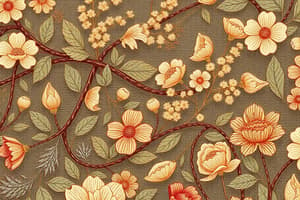Podcast
Questions and Answers
What color indicates a positive result in the Anthrone test for carbohydrates?
What color indicates a positive result in the Anthrone test for carbohydrates?
- Blue-green (correct)
- Red
- Purple ring
- Brown
Which test is specifically used to identify pentoses?
Which test is specifically used to identify pentoses?
- Bi al's test (correct)
- Benedict's test
- Seliwanoff test
- Barfoed's test
Which of the following is the main reducing agent used in Fehling's test?
Which of the following is the main reducing agent used in Fehling's test?
- Coppersulfate
- Sodium citrate
- Cupric ion (correct)
- Tartrate ion
How long does it typically take for ketohexoses to react in the Seliwanoff test?
How long does it typically take for ketohexoses to react in the Seliwanoff test?
What type of product is formed from the oxidation of galactose in the Mucic Acid test?
What type of product is formed from the oxidation of galactose in the Mucic Acid test?
Which test differentiates between aldohexoses and ketohexoses based on time of reaction?
Which test differentiates between aldohexoses and ketohexoses based on time of reaction?
What indicates a positive result in the Barfoed's test?
What indicates a positive result in the Barfoed's test?
Which of the following carbohydrate types does the Molisch test identify?
Which of the following carbohydrate types does the Molisch test identify?
What is the primary reagent used in the Benedict's test?
What is the primary reagent used in the Benedict's test?
Which of the following sugars is specifically identified by the Mucic Acid test?
Which of the following sugars is specifically identified by the Mucic Acid test?
Which disaccharide is formed by the combination of glucose and galactose?
Which disaccharide is formed by the combination of glucose and galactose?
What type of bond is characteristic of sugars like ribose and glucose?
What type of bond is characteristic of sugars like ribose and glucose?
Which of the following reagents is used in the Fehling's test to identify reducing sugars?
Which of the following reagents is used in the Fehling's test to identify reducing sugars?
Which sugar is characterized as a ketone?
Which sugar is characterized as a ketone?
During the Seliwanoff's test, which color indicates the presence of a ketose sugar?
During the Seliwanoff's test, which color indicates the presence of a ketose sugar?
What byproduct is formed during the mucic acid test when lactose is present?
What byproduct is formed during the mucic acid test when lactose is present?
Which method can be used to identify pentoses in a sugar solution?
Which method can be used to identify pentoses in a sugar solution?
What characteristic change occurs in a reducing sugar during the Benedict's test?
What characteristic change occurs in a reducing sugar during the Benedict's test?
What type of sugars are ribose and deoxyribose classified as?
What type of sugars are ribose and deoxyribose classified as?
Which sugar contains a double bond in its molecular structure?
Which sugar contains a double bond in its molecular structure?
Which term correctly classifies gum based on its carbohydrate structure?
Which term correctly classifies gum based on its carbohydrate structure?
Which of the following substances is classified as a polysaccharide?
Which of the following substances is classified as a polysaccharide?
What reagent is known to oxidize reducing sugars?
What reagent is known to oxidize reducing sugars?
Which test is predominantly employed to identify pentoses?
Which test is predominantly employed to identify pentoses?
What is the role of copper ions in the Benedict’s test?
What is the role of copper ions in the Benedict’s test?
Which carbohydrate is an example of a monosaccharide?
Which carbohydrate is an example of a monosaccharide?
Which of the following compounds is considered a heteropolysaccharide?
Which of the following compounds is considered a heteropolysaccharide?
What type of carbohydrate is maltose classified as?
What type of carbohydrate is maltose classified as?
Which test can be used to identify reducing sugars aside from the Benedict's test?
Which test can be used to identify reducing sugars aside from the Benedict's test?
Which of the following is NOT a reducing sugar?
Which of the following is NOT a reducing sugar?
Flashcards
Disaccharide
Disaccharide
A carbohydrate formed by the combination of two monosaccharides.
Covalent Bond
Covalent Bond
A chemical bond formed by sharing electrons between atoms.
Monosaccharide
Monosaccharide
A simple sugar that cannot be broken down into smaller sugars.
Tollen's test
Tollen's test
Signup and view all the flashcards
Benedict's test
Benedict's test
Signup and view all the flashcards
Lactose
Lactose
Signup and view all the flashcards
Fructose
Fructose
Signup and view all the flashcards
Galactose
Galactose
Signup and view all the flashcards
Seliwanoff's test
Seliwanoff's test
Signup and view all the flashcards
Bials test
Bials test
Signup and view all the flashcards
Homopolysaccharide
Homopolysaccharide
Signup and view all the flashcards
Heteropolysaccharide
Heteropolysaccharide
Signup and view all the flashcards
Polysaccharide
Polysaccharide
Signup and view all the flashcards
Reducing sugar
Reducing sugar
Signup and view all the flashcards
Benedict's reagent
Benedict's reagent
Signup and view all the flashcards
Bial's test
Bial's test
Signup and view all the flashcards
Mucic test
Mucic test
Signup and view all the flashcards
Inulin
Inulin
Signup and view all the flashcards
Monosaccharide
Monosaccharide
Signup and view all the flashcards
Tollen's reagent
Tollen's reagent
Signup and view all the flashcards
Molisch Test
Molisch Test
Signup and view all the flashcards
Anthrone Test
Anthrone Test
Signup and view all the flashcards
Barfoed's Test
Barfoed's Test
Signup and view all the flashcards
Seliwanoff's test
Seliwanoff's test
Signup and view all the flashcards
Bial's Test
Bial's Test
Signup and view all the flashcards
Benedict's Test
Benedict's Test
Signup and view all the flashcards
Fehling's Test
Fehling's Test
Signup and view all the flashcards
Mucic Acid Test
Mucic Acid Test
Signup and view all the flashcards
Reducing Sugar
Reducing Sugar
Signup and view all the flashcards
Carbohydrate Identification
Carbohydrate Identification
Signup and view all the flashcards
Study Notes
Carbohydrate Identification
- Carbohydrates are primarily energy sources, composed of carbon, hydrogen, and oxygen.
- Historically, they were considered hydrates of carbon (H₂O).
- Classified as polyhydroxyaldehydes or polyhydroxyketones.
- Three main classes studied: monosaccharides, oligosaccharides (disaccharides), and polysaccharides.
Monosaccharides
- Crystalline, water-soluble compounds.
- Simple sugars; one carbonyl group and multiple hydroxyl groups.
- Common hexoses include glucose, fructose, and galactose; pentoses include arabinose and xylose.
- Aliphatic aldehydes or ketones.
Oligosaccharides (Disaccharides)
- Relatively low molecular weight polymers (2-20 monosaccharide units).
- Covalently bonded through glycosidic linkages.
- Examples include sucrose, lactose, and maltose.
Polysaccharides
- High molecular weight polymers (more than 20 monosaccharide units).
- Examples include glycogen (animal storage), starch (plant storage), cellulose (fiber), and inulin (fructose storage).
- Homopolysaccharides: Contain only one type of monosaccharide (e.g., starch, cellulose, glycogen).
- Heteropolysaccharides: Contain more than one type of monosaccharide (e.g., pectin, hemicellulose, gums).
Carbohydrate Nomenclature
- Saccharide names end in -ose (e.g., glucose, fructose).
- Names indicate the functional group (aldo- for aldehyde, keto- for ketone) and the number of carbons (e.g., aldohexose, ketohexose).
Studying That Suits You
Use AI to generate personalized quizzes and flashcards to suit your learning preferences.




